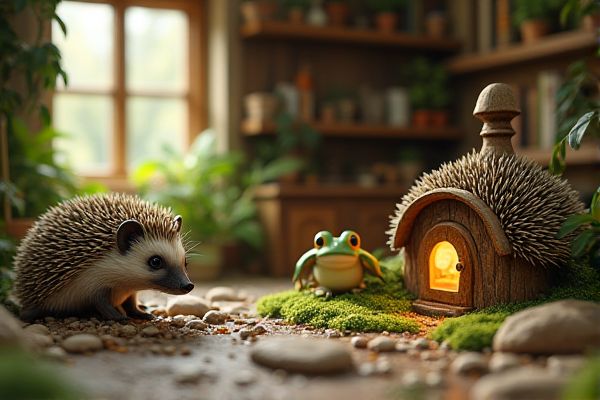
Choosing between a hedgehog house and a frog hotel depends on providing the right habitat tailored to each species' needs, such as dry, insulated shelter for hedgehogs and damp, shaded environments for frogs. Exploring the benefits and design features of both options will help you create the perfect refuge for your garden friends--read on to discover more.
Table of Comparison
| Feature | Hedgehog House | Frog Hotel |
|---|---|---|
| Purpose | Provides shelter and nesting for hedgehogs | Offers habitat and breeding space for frogs |
| Material | Wood, with dry leaves or straw bedding | Waterproof wood or stone, with water pools |
| Size | Typically 40cm x 30cm x 20cm | Varies; usually includes water area 50cm x 50cm |
| Location | Shaded garden areas close to ground | Near ponds or moist areas with partial sun |
| Climate Suitability | Temperate climates, avoids direct rain | Humid environments, supports amphibian skin |
| Maintenance | Clean annually, refresh bedding | Check water quality, clean regularly |
| Benefits | Supports hedgehog population, controls pests | Promotes frog breeding, natural insect control |
Introduction: Why Wildlife Shelters Matter
Wildlife shelters provide essential refuge for creatures like hedgehogs and frogs, enhancing biodiversity and supporting local ecosystems. A hedgehog house offers safe nesting spots that protect these small mammals from predators and harsh weather, while a frog hotel creates moist, sheltered environments vital for amphibian survival and breeding. Choosing the right shelter for your garden encourages a healthy habitat, benefiting both species and contributing to ecological balance.
Hedgehog House: Purpose and Benefits
A hedgehog house provides essential shelter and safety for hedgehogs, helping to protect them from predators and harsh weather conditions. Its design encourages natural behaviors such as nesting and hibernation, supporting local biodiversity and hedgehog population stability. You can enhance garden wildlife by installing a hedgehog house, fostering a healthy ecosystem.
Frog Hotel: Purpose and Benefits
Frog hotels provide essential shelter and breeding sites for frogs, supporting their survival in urban and garden environments. These structures help maintain local biodiversity by offering safe habitats that protect frogs from predators and harsh weather conditions. Your garden benefits from a frog hotel by encouraging natural pest control, as frogs consume insects and pests effectively.
Key Differences Between Hedgehog Houses and Frog Hotels
Hedgehog houses are designed with small entrances and elevated floors to protect hedgehogs from predators and dampness, whereas frog hotels feature multiple chambers and moisture-retentive materials to create ideal breeding and hibernation environments for amphibians. Hedgehog houses typically prioritize insulation and dry bedding to support hedgehog health, while frog hotels emphasize water retention, shade, and humidity control to mimic natural pond margins. The structural design and materials used reflect the specific habitat needs of each species, ensuring effective shelter and increased survival rates.
Ideal Locations for Hedgehog Houses vs Frog Hotels
Hedgehog houses thrive in quiet, sheltered spots with dense vegetation, such as garden corners or under hedge rows, offering protection from predators and harsh weather. Frog hotels require moist, shaded areas near ponds or water bodies, promoting humidity and easy access for amphibians. To support local wildlife, consider your garden's natural features and water sources when selecting between a hedgehog house or frog hotel for your outdoor space.
Materials and Design Considerations
Hedgehog houses typically use untreated wood with small, secure entrances to protect from predators and harsh weather, promoting insulation and ventilation suited for hibernation. Frog hotels often feature natural materials like bark, moss, and leaf litter, arranged in layered compartments that retain moisture and offer refuge for amphibians. Both designs emphasize durability and habitat mimicry but cater to the distinct environmental needs of each species.
Installation and Maintenance Tips
When installing a hedgehog house, choose a quiet, sheltered spot with dry bedding to protect your pet from harsh weather and predators, while a frog hotel requires damp, shaded areas with natural materials like leaves and moss to maintain moisture. Regularly clean and inspect hedgehog houses to prevent parasites and replace bedding seasonally, whereas frog hotels benefit from occasional gentle misting to sustain humidity and thorough checks to avoid mold buildup. Your careful attention to suitable placement and upkeep ensures a safe, comfortable habitat for either wildlife.
Attracting Hedgehogs vs Attracting Frogs
Hedgehog houses are designed with dry, sheltered chambers and small entry holes to attract hedgehogs seeking safe nesting sites. Frog hotels, in contrast, feature damp environments, shallow water basins, and abundant leaf litter to provide amphibians with moisture and hiding spots essential for breeding and overwintering. Effective habitat attraction requires tailoring the microenvironment and structural elements to meet the specific needs of hedgehogs or frogs.
Common Mistakes to Avoid
When choosing between a hedgehog house and a frog hotel, avoid placing the structure in an overly exposed area, as both species require sheltered environments with natural cover. Do not select materials that retain excessive moisture or lack proper ventilation, since hedgehogs need dry conditions while frogs thrive in humidity, necessitating different habitat features. Avoid overcrowding by ensuring sufficient space and separate sections to prevent stress and territorial disputes among inhabitants.
Conclusion: Choosing the Best Wildlife Shelter for Your Garden
Selecting the best wildlife shelter for your garden depends on the species you aim to support, with hedgehog houses providing safe, insulated nesting spots for solitary hedgehogs and frog hotels offering moist, protected environments ideal for amphibians. Evaluating your garden's ecosystem and native wildlife needs helps ensure you provide effective, species-specific habitats that encourage biodiversity. Your commitment to maintaining these shelters will enhance local wildlife survival and promote a balanced garden ecosystem.
 homyna.com
homyna.com